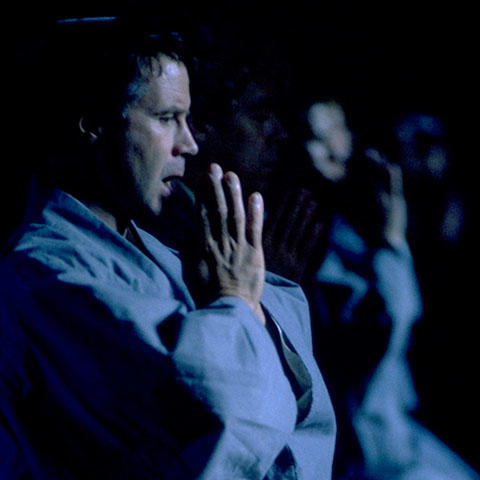
Intensive Zen meditation retreats, or sesshins, such as one in Mt. Temper, New York, are designed for participants to focus intensively on monastic Buddhist practice and meditation. Retreats include many rituals to allow students to fully immerse themselves in their practice—even during mealtime.
View full album
For sheer intensity and singularity of purpose, participating in a sesshin is the essence of Zen monastic practice. During such meditation retreats, typically a week in length, the practitioner engages in breath-counting practice, Rinzai koan study or Soto shikantaza, “just sitting,” for ten or more hours a day. Typically, no talking is allowed, except for asking necessary questions during work practice and in interview with the teacher. Eyes should be constantly directed downwards, so that all of one’s concentration can be focused inward.
Zen Mountain Monastery in Mt. Tremper, New York, holds a sesshin once a month. Each day of the retreat, the participants are out of bed in time to be in the Buddha hall by 5:00 AM, when a wooden block is struck and a handbell sounded to signal the start of the day’s first of three zazen sessions. During the sitting, a monk typically walks around the room with the keisaku, a flat stick used to strike people on the shoulders in order to wake them up and relieve body tension. These zazen sessions are broken into two 35-minute sittings with a 20-minute kinhin, or walking meditation, in between, which allows participants to stretch their legs and breathe the fresh outdoor air. Following zazen are chanting services, in which traditional Zen chants, most of which have been translated into English, are rhythmically intoned.
Even meals are regarded as an opportunity for meditation at a sesshin. Both breakfast and lunch are oryoki, or formal, taking place in the Buddha Hall. At the beginning of the sesshin, all students receive sets of oryoki bowls, tied into bundles with cloth napkins. For these meals, students rise together and walk in file to get their bowls from the shelves, then return to their seats, where they unpack and arrange their bowls in sync with one another, folding the bottom napkin into a diamond-shaped placemat. A drum roll begins very softly, builds up in volume and then cuts back again. It repeats, getting louder each time, until the last roll climbs to a great thunder. Following this prelude, the students join in some vibrant chants while designated long-term residents of Zen Mountain Monastery serve the food. The students indicate with hand signals how much food they want. Once the meal has started each person must keep track of the pace at which everyone else is eating to make sure that they all finish at the same time. They then wash their bowls with tea and drink the remains, put the pieces back together, and tie the bundle with a special “lotus knot” dangling from the top.
Part of each day’s schedule is caretaking practice, in which students work in the garden, empty the trash, clean the bathrooms, and perform various other tasks to maintain the monastery facilities. This too is a form of meditation; all students are expected fully to focus their awareness on the job in which they are engaged.
Over the course of the sesshin, students have four opportunities to meet the Zen teacher for dokusan, a private interview for face-to-face teaching. While at all times this encounter is an intense affair, during sesshin the drama of these few moments of exchange feels greatly heightened. In the interview, those students who are working on a koan are asked to demonstrate their understanding of it. “Don’t tell me, show me!” is a well-known injunction since one cannot get away with proffering an intellectual response. Students who are counting breaths or practicing shikantaza can ask a question about their practice or some other concern, although spontaneity and the demonstration of insight are still encouraged. These exchanges are intended to snap the students into an understanding of their True nature by helping them to react in a natural and spontaneous manner.
The sesshin is designed to enable one to plunge ahead in one’s practice. Indeed, the goal of sesshin is nothing less than satori, the realization of one’s own Buddha nature.